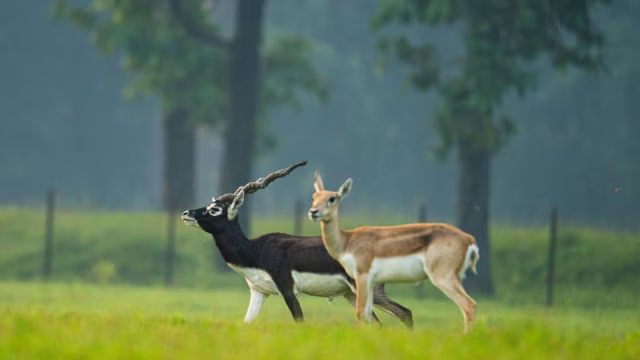Chhattisgarh
Revival of Blackbuck in Barnawapara Wildlife Sanctuary
- 21 Oct 2025
- 3 min read
Why in News?
Chhattisgarh’s Barnawapara Wildlife Sanctuary has successfully revived the blackbuck population nearly five decades after its local extinction, representing a significant milestone in India’s wildlife conservation efforts.
Key Points
- Reintroduction Initiative: The Chhattisgarh Forest Department initiated a five-year blackbuck reintroduction programme (2021–2026) aimed at restoring the species to its natural habitat.
- Translocation Effort: A total of 77 blackbucks were introduced — 50 from the National Zoological Park (Delhi) and 27 from Kanan Pendari Zoological Garden (Bilaspur).
- Population Recovery: From zero population in the 1970s, Barnawapara now hosts around 190 blackbucks, showcasing the success of the programme.
- Future Expansion: Encouraged by success, the forest department plans to extend the model to other sanctuaries, including Gomardha Wildlife Sanctuary (Raigarh), known for its ideal grassland ecosystem.
About Blackbucks
- About: The Blackbuck (Antilope cervicapra), or Indian Antelope, is a diurnal ( day-active) animal found in India (mainly in Rajasthan, Gujarat, Madhya Pradesh, Tamil Nadu, and Odisha) and Nepal,.
- It is regarded as the symbol of India’s grassland ecosystem.
- Key Blackbuck Habitats: Velavadar Blackbuck Sanctuary (Gujarat), Point Calimere Wildlife Sanctuary (Tamil Nadu), and Tal Chhapar Sanctuary (Rajasthan).
- Protection Status:
- Wildlife Protection Act, 1972: Schedule I
- IUCN Status: Least Concern
- CITES: Appendix III
- Threats: Habitat loss and fragmentation, deforestation, natural disasters, and illegal hunting pose major risks to the species.
About Barnawapara Wildlife Sanctuary
- Location & Name: It is situated in the northeastern corner of Raipur district, Chhattisgarh, and is named after the Bar and Nawapara forest villages at its heart.
- Terrain & Geography: Features undulating terrain with numerous low and high hillocks. Water sources include tributaries of the Mahanadi River, with River Balamdehi forming the western boundary and Jonk River the north-eastern boundary.
- Forest Type: The sanctuary has well-stocked forests, classified as teak, sal, and mixed forests.
- Wildlife: Commonly sighted animals include Indian bison (Gaur), Cheetal, Sambhar, Neelgai, and Wild boar.







